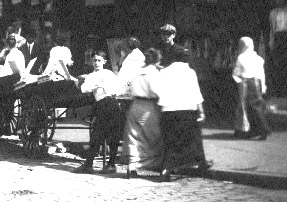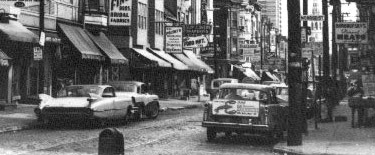|
|
| The
Fabric of Our
Lives: A History of Philadelphia's South Fourth Street by Michele Winitsky Palmer |
 This photo/oral history
is a
tribute to the generation who started it all, including my father, Louis Winitsky. |
For over a century,
fabrics and
Fourth Street have been interwoven. Many of the Jewish immigrants
who settled there around the turn of the twentieth century were tailors
or seamstresses. Working long hours in sweatshops, they produced
the clothing that made Philadelphia the leading men's apparel
manufacturer
in the world. Other Jewish immigrants on Fourth Street included peddlers who hawked dry goods like fabric remnants, sewing supplies, sheets and curtains. They worked out of pushcarts that lined the streets, or from stands -- tables made of boards and sawhorses -- that leaned against the storefronts. Eventually, they opened up fabric stores, mainly in the 700 block between Bainbridge and Catherine streets. Today, the pushcarts are gone, as are many of the old fabric establishments. Still, a number of them remain, along with a new generation of entrepreneurs, and a new name for the area -- Fabric Row.Note: Unless otherwise indicated, all quotes are from oral histories I conducted from 1997-1998. |
|
Known in Yiddish as "Der Ferder" (the Fourth), South Fourth Street was a bustling marketplace, a lifeline that ran through the immigrant Jewish community, from Lombard Street to Washington Avenue. Besides dry goods and fabric businesses, it included dozens of kosher butcher shops, fish stores, and dairy stores, plus hundreds of fruit and vegetable carts and stands. "Our neighborhood includes ... Fourth Street, Philadelphia's closest approach to New York's lower East Side, where we have the pushcarts, crowded streets and pavements, the open air display of calico, candy, pickles and fish for sale... Ours is an economically but not a morally depressed neighborhood."1914-15 Annual Report of the Neighborhood Center, the settlement house at 422-28 Bainbridge Street |
Pushcarts on Fourth Street, 1914 photo courtesy of the Philadelphia City Archives |
|
One of the oldest fabric related businesses still on Fourth Street is Marmelstein's, a home decorating and bridal accessories shop, which began in 1919. "Actually, [the
business] started
with just a little suitcase with thread, needles, thimbles... [My
parents,
Abraham and Dora Marmelstein] had a stand. They were out in all
kinds
of weather. They sold notions and trimming... They lived at 769,
751, 733, then back to 751, then eventually across to here [760].
So all of us have spent our lives on this street." |
|
 Looking north on Fourth Street, 1926 |
By the 1920's, many of
the peddlers
and stand keepers had moved up the business ladder into dry goods and
fabric
stores. Tailors and dressmakers came from all over the city to
buy
fabrics from them.
Stapler's Fabrics, which
began
on a pushcart, was already a well established business. Like most
of the fabric stores, it was family run, with every member of the
family
participating.
photo left, courtesy of the Philadelphia City Archives |
|
"The entire family,
including
all the sisters, were in the business. There were eight all
together,
and the whole life revolved around that store. They lived up
above.
My father would say he lived on the roof! But they ate and slept
and drank there. Everything was done in that store... [My mother]
met my father [there]. Her mother took her there to have her
clothes
made, and that's how they met." Because merchants lived above their stores, they often kept long hours. "We stood open seven days a week, even till eleven, twelve o'clock at night. We never went to sleep."- Viola Adler |
|
| Fourth Street didn't
feel the
effects of the Depression as much as other areas because people bought
fabrics to sew their own clothes.
"The fabric stores
survived
in the Depression. They worked on a close markup. I'm not
saying
they made fortunes, but the stores were busy... People couldn't afford
to buy clothes, so they made them.. If you didn't know how to sew, you
learned how." Samuel Goldberg
|
photo
courtesy of the Philadelphia City
Archives
|
|
To further promote trade, a business association was established. "On August 15, 1933,
South
Fourth St. Business Merchants gathered together at the Talmud Torah,
314
Catherine Street for the purpose of discussing the possibilities of an
Association for our purposes along south Fourth St. in the vicinity of
Washington Ave. to South St.... |
|
| For many merchants,
World War
II proved to be more challenging than the Depression. Because
fabric
manufacturers were supplying the armed forces, it was difficult to keep
the stores stocked.
"I used to commute to
New York
every day [to find fabrics]." "We used to close a
lot because
we didn't have the merchandise, and we weren't going to pay black
market
prices." - Blossom Polsky Markind Photo left, courtesy of The Atwater Kent Museum |
|
|
Moreover, the stores had to close Tuesdays and Thursdays at 6 p.m. to conserve electricity. According to Gertrude Zubrow Gubernick, her father, Nathan Zubrow, had a fire alarm bell hooked up to a light switch in his store. At 6 p.m. he rang the bell as the signal for the shops to close. Sometimes a storekeeper asked him to hold off ringing the bell -- if he was in the middle of a sale -- or to ring it early, so a non-buying customer wouldn't go to a competitor! The war was hard on the Jewish merchants for other reasons, too. They worried about their sons in the army, and about the fate of relatives still in Europe. "The Holocaust was an
emotional
drain on my parents. They both had left large families behind."
|
|
| After the war, life on
Fourth
Street changed dramatically. Post-war prosperity meant fulfilling
the American dream of a house in the suburbs. Merchants who had
once
lived above their stores now commuted to work. Because of the
post-war
building boom, people began buying more home decorative fabrics.
To go along with the trend, many stores shifted their merchandise from
dress fabrics and ready-made curtains to decorative fabrics. photo right,
courtesy of
the Philadelphia City Archives
|
Fourth Street Post World War II |
|
"[Everyone] had new
homes and
... enough money, and they wanted everything decorated."
"Most people went
into custom-made
-- the heavy draperies with the sheers underneath, wall-to-wall, the
whole
works." "People knew the name
'Silk
Leaders,' so when we went into the drapery business, [we] just never
changed
it. People come in here all the time saying, 'Where are your
silks?'
" There was a new level of sophistication on Fourth Street after the war. A few businesses expanded into wholesale as well as retail trade. These included Rosenblitt's ( Roseline Fabrics) and Winitsky & Co. (Win-tex Fabrics). Merchants like Samuel Goldberg went on buying trips around the world. And in the 1950's, pushcarts were outlawed. "[Some] people
thought the
end of the world was coming when the pushcarts left...[Instead] it
really
lifted the level of customer and sale on the street." "Fourth Street is
still known
all over the United States... You build a reputation." |
|
 |
 Photo above: Phil
Morgenstern
(left) and Louis Winitsky,
partners in Winitsky & Co. and Win-tex Fabrics, 724 South Fourth Street, on a 1950's buying trip in New York. Their other partner, Max Rapoport, was probably back on Fourth Street minding the store. Photo left: Samuel
Rosenthal
sold woolens here at 747 South
Fourth Street from 1917 until the early 1930's when he moved his business to Fifth Street. By then, Fourth Street was special- izing in ladies' silks and woolens, while Fifth Street specialized in men's woolens. Rosenthal's is now a third generation business. |
| Family
Finder: Seeking information on Leon H. Hahn: He was in the
dry goods business
in Philadelphia before and after WWII. Contact Bill Meyers at BPMeyers@aol.com Were your parents or grandparents in the fabric business on Fourth Street? We'll be pleased to add photos of them and/or their store to the Fourth Street Family Album. Send photos, comments, and any questions to: mpalmer@fabricmuseum.org |
|